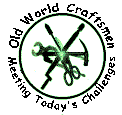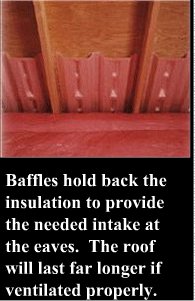 |
POWER VS. PASSIVE ATTIC VENTILATION, MOISTURE AND THE NEED FOR INTAKE VENTS
|
|||||||||||||||
| Common Questions & Conundrums Regarding Attic Ventilation:
Will attic ventilation cure my attic moisture problem? That question is hard to answer. If an attic is exhibiting a moisture problem, the source of that moisture should be ascertained. The presense of mold in the attic can be serious and if a moisture problem has been there for some time, you probably have a mold problem. Start in the basement or crawlspace and work your way up. Interior moisture readings must be taken (in the winter months). Air Bypasses & Air Sealing issues must be ruled out. Once the moisture problem is resolved, your attic should be ventilated properly to ensure that summer heat and any moisture that may be getting into the attic areas can be properly vented out.
What is better, passive Ridge Venting or Power Attic Ventilation systems? To answer this question, a look at the construction of the building. Some homes are constructed with little ridge line footage available for venting, such as in hip roof construction. In these cases, power vents will work nicely. Existing situations need to be analyzed before recommendations can be made, but the concern for some homes with passive attic venting, is with the propensity for stagnation on some winter days. This is explained below.
Will a Power Attic Fan or ventilator with proper Intake Vents, work better than passive Ridge Venting and Soffit Venting in the winter months? With a properly configured system, the powered system will work better than the passive system for a couple of reasons. The power fan can be connected to a humidistat along with a thermostat. This enables the system to evacuate moisture in the winter months. The problem in the climate of the Northeast region is that there are times in the winter months when the temperature of attics can be lower than the temperature outside. This usually occurs when temperatures outside are climbing or have climbed from a lower state. When an attic floor is heavily insulated, the attic temperature more closely resembles the out-of-doors. When it warms a bit (and not a lot of warming is necessary) outside, the attic is cooler than the out-of-doors. At these times, the passively vented attic is not vented at all and the air inside the attic is stagnant. For some buildings, this is not a major concern, but if moisture leaks into the attic, it will not be evacuated by a passive attic ventilation system. Every attic has some degree of moisture that seeps from the conditioned spaces in the winter months. According to the degree of attentiveness to detail that has been paid to Air Sealing of Bypasses, Vapor Retarders on the ceilings, Power Exhaust Vents for bathrooms and the existing presence of moisture in the attic, etc., the need for a properly configured power roof ventilation system can be weighed by a trained ventilation professional.
Should a Power Attic Fan be installed along with Ridge Vents and Gable Vents? No! Only one type of exhaust vent should be employed on a given roof. The most ridiculous thing to see on a rooftop is a power vent directly beneath a ridge vent. The power vent becomes an electrically powered roof heater in the summer as it pulls air in from the ridge vent (the point of least resistance). The super heated air in the summer months can exceed 150 degrees. This hot air is pulled in and blown out in a loop of wasted energy. This situation is actually common! When exhaust vent types are mixed, wind blown over the roof and against gable ends enters one exhaust vent type and exits another. Rain is often pulled into the attic when it enters one type of exhaust vent during a wind and rain event. How important are Soffit Vents or Eave Vents? These vents are very important as an exhaust vent without an intake is not going to do much except maybe puff out a little air from thermal buoyancy. A power vent without intake vents provides negative pressure in the attic and pulls moisture and conditioned air from the living area into the attic.
|
|||||||||||||||
